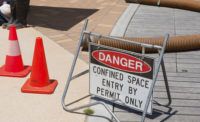First responders focus on confined spaces

Although confined space rescues comprise a relatively small percentage of the operations performed by fire departments in the U.S., they are among the most challenging and dangerous. In fact, as hazardous as confined spaces are for the people who initially become trapped in them, they are even more deadly for would-be rescuers, who account for nearly 60 percent of all confined space deaths.
A review of recent training events shows that many fire departments are ensuring that their personnel are properly trained in how to safely perform confined space rescues.
In Hillsdale, Michigan this week, firefighters with the Hillsdale City Fire Department were put through their paces underground, thanks to the removal of a series of manhole covers. Specialized equipment was used to lower some trainees underground, where they had to work their way through a tunnel. Others practiced setting up ladders and reviewing how to flush and connect to a fire hydrant.
In Tucson, more than two dozen first responders from seven different public safety agencies gathered in October for confined space training, hosted by the Tucson Fire Department and sponsored by the International Association of Firefighters (IAFF).
The sessions, which were conducted over several days, covered everything from harness placement to how to use a tripod. Tucson has many confined spaces used for electrical work, which makes training crucial.
Firefighters in Marietta, Ohio underwent a three-day training session in confined space rescue that included both classroom education and then scenarios that allowed attendees to use the skills – like knot-tying – that they learned in the classroom. Firefighters went through a simulation in which they rescued a person from a tank.
Earlier this month in Batavia, New York, firefighters were trained in confined-space hazards; air monitoring and ventilation; space isolation techniques; respiratory protection, retrieval systems and retrieval methods by the New York State Department of Homeland Security and the Office of Fire Prevention and Control.
Trainees learned how to evaluate a specific confined-space incident and conduct a simulated rescue of a victim.
Looking for a reprint of this article?
From high-res PDFs to custom plaques, order your copy today!



